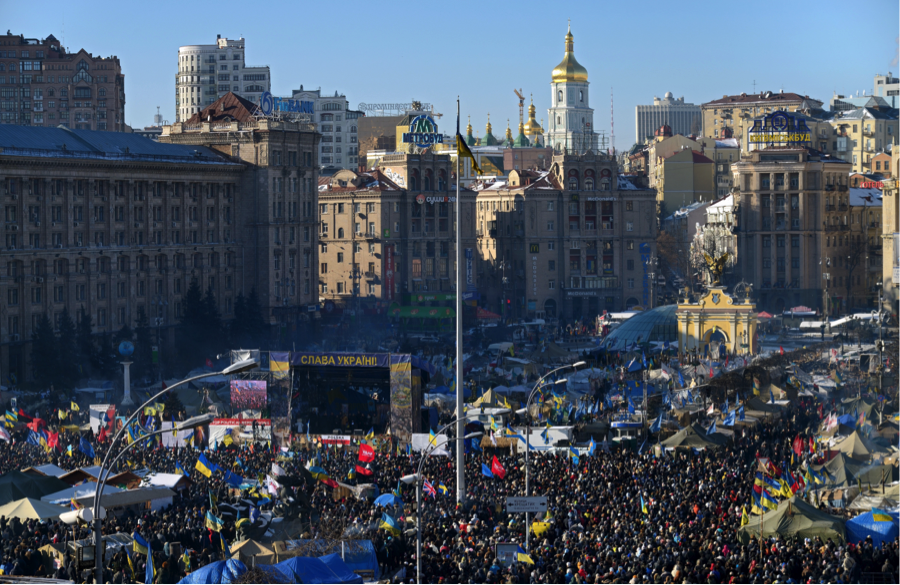
With the world’s media coverage of Ukraine heavily focused on Russia’s invasion and questionable annexation of Crimea, it was easy to miss the economic news that came out of the country recently. On March 27th, IMF Mission Chief for Ukraine Nikolay Gueorguiev announced [1] that a stand-by agreement had been reached that would unlock US$27 billion in external funding to Ukraine over the next two years, with US$14-18 billion of that coming directly from the IMF. In order to access these funds, Ukrainian leadership agreed to enact certain fiscal, monetary, and policy reforms, mainly meant to reign in unsustainably high current account deficit levels, which are currently at 9 percent of GDP [2].
This is not the not the first time in recent months that the IMF has offered Ukraine a loan package to help it out of its precarious economic position. In November, then-president Viktor Yanukovych rejected IMF loans that were contingent on Ukraine reforming its costly gas subsidy program that allowed Ukrainian consumers to heat their homes for well below the market price at the expense of the government. This time around, Ukraine did not have the flexibility to dictate terms of an agreement. Without any external funding, Ukraine was set to default on debts, as its foreign currency reserves barely cover two months worth of imports. The National Bank of Ukraine (NBU) has already been taking extreme measures to support its overvalued currency, and 10-year bond yields reached new highs of 9 percent, a sign that investors questioned Ukraine’s ability to pay its debts. This remained true even before Russia’s invasion of Crimea, which resulted in the seizure of billions of dollars worth of state owned assets and fostered further investor uncertainty. With a hostile Russia no longer willing to support the current Ukrainian government, agreeing to an IMF deal was the only way for Ukraine to avoid a massive financial and debt crisis.
Part of the IMF’s responsibility is to act as an “international lender of last resort,” providing liquidity to a country when no one else will is willing to take the risk. Historically, reception to IMF programs has been mixed. Often making loans contingent on tariff removal, privatization of state enterprise, and government austerity, the IMF has received criticism [3] from opponents who believe that these neoliberal economic policies have actually hindered growth in the developing countries that accepted structural adjustment program reforms. However, proponents claim that these reforms were necessary to avoid future crises within the borrowing country.
Although not yet binding, the March 27th IMF press release outlined the reforms that Ukraine would agree to undertake in order to receive funding:
- Monetary Reforms: On February 7th, the NBU agreed to end its pegged exchange rate system in favor of a floating rate. This was partly to appease the IMF, which had demanded this reform, and partly because the NBU was losing its capacity to prop up the hryvnia to an artificially high value amongst an ongoing investor run on the currency. The value against the dollar immediately dropped 25 percent. As part of the agreement, the IMF has required Ukraine to maintain a floating currency system, which will make imports more expensive to consumers in the short run, but should also make Ukrainian manufactures more competitive, both domestically and abroad. An artificially high currency and an inefficient manufacturing sector have caused Ukrainian exports to drastically suffer over the last few years. Ukraine’s economy, which is heavily reliant on large-scale agriculture and heavy industry in the East, can benefit from an export boost that would come from the price advantages abroad made possible through a weaker currency. Furthermore, Ukrainian primary agricultural products gain a price advantage domestically. However, everyday Ukrainians will see themselves paying more for imported goods, including the essentials of gas and packaged foods from abroad.
- Fiscal Reforms: The IMF would like Ukraine to reduce their fiscal deficit from 4.6 percent of GDP to 2.5 percent of GDP by 2016. Although the specifics were not laid out in the press release, a plan would probably include both revenue increases (closing tax loopholes or adding new taxes) and spending cuts (most likely to pensioners).
- Energy Sector Reforms: Although necessary, the reforms that Ukraine agreed to make to its energy sector will probably be the hardest for consumers to swallow. Ukraine’s state-run gas company, Naftogaz, has been operating at annual losses of $2 billion since 2009 by allowing consumers heat their homes well below market prices. Ukraine agreed to end this policy, which should cause prices to rise by 50 percent for consumers. To make matters worse, on April 1, Gazprom, the Russian state-run gas company announced that it would scrap a previously agreed to discount and raise the price of gas exports to Ukraine by 40 percent.
- Financial Sector and Governance Reforms: The last set of requirements the IMF imposed on Ukraine have to do with implementing laws to clean up corruption and increase transparency in both the public and private sector. Under President Yanukovych, billions of dollars where syphoned into the pockets of friends, family, and connected officials who fell in line with the mafia-like system of rule. Opening bank and government agencies to independent audits will not please the politically powerful in Ukraine, but will signify the most serious efforts to tackle the corruption problem that has plagued the country since its independence in 1991.
Ukraine would have been facing certain economic hardship in the near future regardless of the Euromaidan protests that took place and the subsequent ousting of the president. Conflict with Russia worsened Ukraine’s economic quagmire, but policy under Viktor Yanukovych was equivalent to a ticking time bomb of poor productivity, corruption, and unsustainable debt – the timer of which would periodically be nudged back by the unsustainable practice of continual Central Bank and Russian debt purchases. Now, in the short term, Ukrainian citizens face a dim economic outlook and increased prices for essential goods they depend on to get by. There is no doubt that citizens in Ukraine will feel the squeeze, and many feeling beleaguered by their situation will be under the impression that they were sold out by their new government. To mitigate this, the interim government should negotiate haircuts on the country’s creditors to reduce the debt burden on Ukrainian citizens, the way Cyprus managed to do in its 2013 IMF/EU bailout. However, accepting this IMF package alleviated the risk of a full economic collapse barring further military conflict with Russia, something that seemed likely just a few weeks ago. Furthermore, enacting these reforms sooner rather than later should help Ukraine’s economy come back modernized and rejuvenated in a few years, less dependent on Russia and ready for a future of integration with the West.
Stefan Klos
Economics and Math ’14
References:


